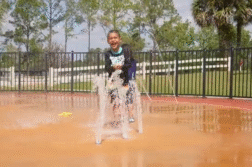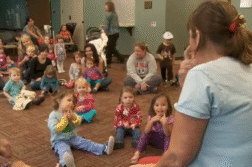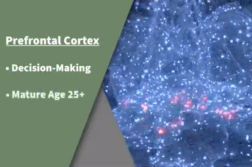LOUISVILLE, Ky. (Ivanhoe Newswire)— As an expectant or new parent, it’s something that nothing can prepare you for. An injury at birth, or an illness right after that causes a problem with the spinal cord and may prevent a child from ever walking. Scientists at the University of Louisville have designed a machine and therapy that works with a child’s still developing neurological system to help them regain movement. Ivanhoe has more. Pediatric spinal cord injury
Every step little Luke Madson takes is nothing short of a miracle. Born at just 33 weeks, Luke spent the first month of his life in the NICU. Shortly after he came home to live with mom, Sarah, dad, Tim, and big sister Ruthie, Sarah noticed something wasn’t right.
“Like he couldn’t hold his head up. He wasn’t really moving his arms and legs very much,” explained Sarah.
Doctors tested Luke and found he had a spinal cord injury that likely occurred in the womb or at birth.
“They told us that he would be fully paralyzed, and on a ventilator if that was showing up as an injury for us as an adult. But it was pretty miraculous that he was moving and breathing on his own,” continued Sarah.
Now at just over two years old, doctors say Luke is making huge developmental strides. Experts credit the improvement on an intensive therapy known as locomotor training. Done on a machine designed just for pediatric patients.
Andrea L. Behrman, Ph.D., PT, Physical Therapist with University of Louisville, stated, “We use a treadmill environment, a harness system to help unweight the child, somewhat.”
Trainers surround Luke and guide his feet. They encourage Luke to play while stepping, engaging his arms and hands.
“We’re trying to realign what typically happens in development with a type of therapy to activate his nervous system, starting at the spinal cord,” continued Behrman.
Researchers say the locomotor training taps into the spinal cord’s ability to help Luke regain movement and control of his midsection. Therapists say after one year of therapy, Luke no longer slumps forward in a chair or walker.
“This locomotor training has given him the opportunity to move. And it’s just like, turned him on. It’s just been life changing for all of us,” smiled Sarah.
Luke does locomotor training on the pediatric treadmill for one hour a day, five days a week, followed by additional physical therapy. The Madson family moved from their hometown of Minneapolis to Louisville so Luke could have the specialized treatment. Andrea Behrman says she can’t tell the Madson’s what Luke’s specific prognosis will be, but she does say he is getting better and stronger.
Contributors to this news report include: Cyndy McGrath, Executive Producer and Field Producer; Kirk Manson, Videographer; and Roque Correa, Editor.
To receive a free weekly e-mail on medical breakthroughs from Ivanhoe, sign up at: http://www.ivanhoe.com/ftk
MEDICAL BREAKTHROUGHS
RESEARCH SUMMARY
TOPIC: PEDIATRIC SPINAL CORD INJURY: LOCOMOTOR TRAINING GETS LUKE ON HIS FEET
REPORT: MB #4984
BACKGROUND: Approximately 20% of spinal cord injuries (SCI) occur in children and adolescents. The incidence of developing scoliosis is greater than 90% if a person is injured prior to the onset of puberty. Younger children who sustain SCIs are more likely to have paraplegia and complete injuries compared to adults. Men are more likely than woman in all age groups except in those 5 years and younger to suffer from SCIs. Children have a higher incidence of spinal cord injury without radiographical abnormality due to immature musculoskeletal system, and properly restrained children in booster seats have decreased the incidence of SCI. Annually just under 1,500 children are admitted to U.S. hospitals annually for SCI treatment.
DIAGNOSING: The symptoms a child experiences will depend on the degree of severity and particular location of their SCI. Signs of SCI can include but are not limited to muscle weakness, partial or complete loss of muscle movement in the chest, arms, or legs, having issues with breathing, experiencing little to no feeling in the chest, arms, or legs, and having a loss of bowel and bladder functions. The higher in the back or neck the injury is located, the more extensive the symptoms will be. Injury in the lower portion of a child’s spine may cause symptoms such as having reduced or absent feelings in their legs, bladder, and bowels. If the SCI is in the upper neck region, they may not be able to move their arms or legs or have difficulty breathing.
(Source: https://www.childrenshospital.org/conditions-and-treatments/conditions/s/spinal-cord-injury)
NEW RESEARCH: A new designation for a regional consortium led by Virginia Commonwealth University will expand research efforts to improve patients’ quality of life and offer opportunities for them to receive the best care for spinal cord injury in the country. A center at Virginia Commonwealth University earned federal designation as one of only 14 Spinal Cord Injury (SCI) Model Systems Centers in the U.S. This makes VCU one of only four centers in the nation to have a dual designation as a SCI and traumatic brain injury (TBI) model systems center. Both federal model systems center designations support research and education efforts to improve the lives of all who have sustained such injuries. The new Spinal Cord Injury Model Systems Center designation includes a grant award from the National Institute on Disability, Independent Living and Rehabilitation Research, totaling $2.2 million over five years, to project director Ashraf Gorgey, Ph.D., a professor at CERSE in the Department of Physical Medicine and Rehabilitation, and co-project director Zina Trost, Ph.D., integrative rehabilitation research scientist at CERSE and associate professor in the Department of Physical Medicine and Rehabilitation. The grant will support research on three projects. One, led by Gorgey, aims to improve hand and arm function to increase patients’ independence and quality-of-life. Another, led by Trost, will enroll participants in a national spinal cord injury database and conduct research studies on spinal cord injury, both in collaboration with other model systems centers and independently. A third, led by Paul Perrin, Ph.D., professor and director of the Social Justice in Disability and Health Lab in the Department of Psychology at VCU College of Humanities and Sciences, will focus on identifying sources of health inequities around spinal cord injury care to improve access and health outcomes.
FOR MORE INFORMATION ON THIS REPORT, PLEASE CONTACT:
BETTY COFFMAN
If this story or any other Ivanhoe story has impacted your life or prompted you or someone you know to seek or change treatments, please let us know by contacting Marjorie Bekaert Thomas at mthomas@ivanhoe.com




